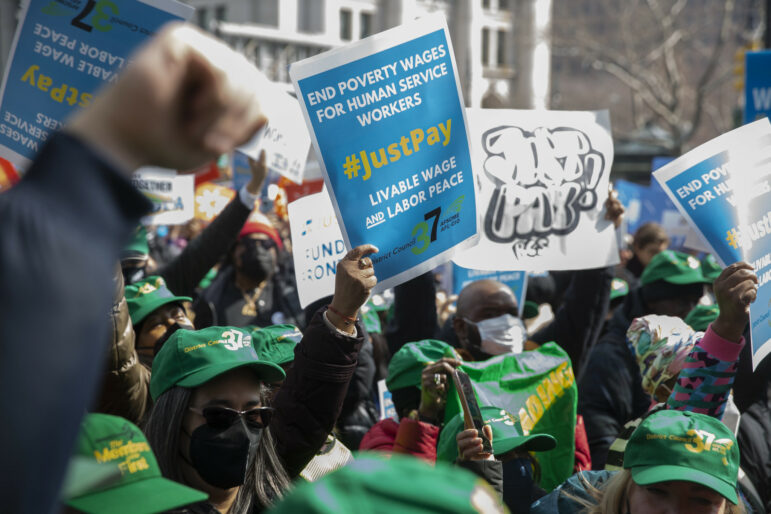“The occupational segregation and income inadequacy rampant across our state today is the direct consequence of policies that have intentionally excluded and marginalized people of color and women and undervalued their labor, especially in care-oriented industries like education, childcare, healthcare and human services more broadly.”

John McCarten/NYC Council Media Unit
A rally for higher wages for New York’s human services workers in 2022.As we take time during Black History Month to pay tribute to the generations before us who fought to advance civil and human rights for Black Americans, it is critical that we also take time to assess the ongoing work that is necessary to protect the progress made and achieve further progress that would ensure true equity and opportunity for all.
A recent policy brief released by the Federation of Protestant Welfare Agencies (FPWA) does just that, revealing a sobering picture of economic deprivation across New York City and state. Using the latest Self-Sufficiency Standard—a basic needs measure developed by the University of Washington—the brief found that nearly 40 percent of New Yorkers are struggling to afford just the basics, like rent, food, and childcare. And because this measure only captures the cost of merely getting by, the number of New Yorkers going without the resources they need to live with dignity and achieve economic security is certainly even higher.
The data also revealed that people of color and women experience this economic deprivation most acutely. For example, Black households make up 13 percent of the total population in New York state but 18 percent of households below the basic needs standard. Interlocking systems of racism and sexism make the inequities even more pronounced for women of color. Black women, for example, experience a disproportionately high rate of income inadequacy, with 57 percent unable to cover their basic needs, compared with 30 percent of white women and 26 percent of white men.
New Yorkers of color and women also bear the brunt of occupational segregation, as these demographic groups are overrepresented in low-wage professions with limited opportunity for economic advancement, which perpetuates cycles of economic instability and limits their ability to build wealth. In fact, people of color are overrepresented in all of the top 10 occupations with the most households below the basic needs standard. In contrast, workers in the top 10 highest-paid occupations were disproportionately white, and predominantly white men. Beyond higher hourly median wages, these jobs also offer better benefits that help build economic security, including health insurance, paid time off, and family leave.
But there’s more to the story: Even when people of color and women are able to make it into high-wage jobs, they still make substantially less than their white male counterparts. Black women software developers, for example, earn on average $23 less an hour—or $47,000 less annually—than their white male peers. In even higher wage occupations, these disparities grow wider. Among lawyers and judges, one of the highest earning occupations, the wage gap between Black women and white men increases, with Black women earning $37 less an hour—or $76,000 less annually—than their white male peers.
This is no accident. The occupational segregation and income inadequacy rampant across our state today is the direct consequence of policies that have intentionally excluded and marginalized people of color and women and undervalued their labor, especially in care-oriented industries like education, childcare, healthcare and human services more broadly.
The depth and breadth of these inequities calls for bold policy change and a “both/and” approach. First, we must dismantle racist systems that perpetuate occupational segregation, and we must also begin building pathways that allow for wealth-building and economic mobility for people of color, women, and other marginalized communities. A crucial first step would include creating a true cost of living measure that enables the state and nation to truly understand what it costs for families to achieve economic security.
This also means improving access to education, enhancing workers’ rights and protections against discrimination and harassment, strengthening unions, and ensuring workers have paid family and medical leave. Just as critical is the need to both raise wages in occupations where New Yorkers are struggling to make ends meet and expand income supports, such as increased childcare subsidies, more robust benefits programs like cash assistance and SNAP, and more generous and inclusive tax credits.
Beyond this, we must also expand access to homeownership and advance policies that support asset building, particularly for Black households. Taken together, policies such as these would begin to meaningfully advance racial and economic justice in our city, state, and nation.
Julia Casey is an income supports policy analyst at FPWA.








